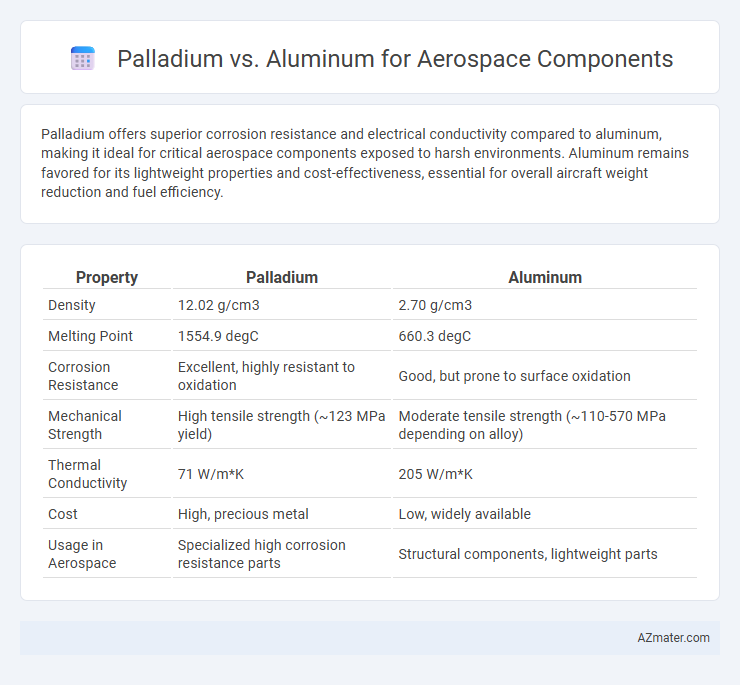Palladium offers superior corrosion resistance and electrical conductivity compared to aluminum, making it ideal for critical aerospace components exposed to harsh environments. Aluminum remains favored for its lightweight properties and cost-effectiveness, essential for overall aircraft weight reduction and fuel efficiency.
Table of Comparison
| Property | Palladium | Aluminum |
|---|---|---|
| Density | 12.02 g/cm3 | 2.70 g/cm3 |
| Melting Point | 1554.9 degC | 660.3 degC |
| Corrosion Resistance | Excellent, highly resistant to oxidation | Good, but prone to surface oxidation |
| Mechanical Strength | High tensile strength (~123 MPa yield) | Moderate tensile strength (~110-570 MPa depending on alloy) |
| Thermal Conductivity | 71 W/m*K | 205 W/m*K |
| Cost | High, precious metal | Low, widely available |
| Usage in Aerospace | Specialized high corrosion resistance parts | Structural components, lightweight parts |
Introduction to Palladium and Aluminum in Aerospace
Palladium and aluminum serve distinct roles in aerospace component manufacturing due to their unique properties. Palladium, prized for its excellent corrosion resistance and catalytic properties, is primarily used in specialized electronic components and coatings within aerospace systems. Aluminum, valued for its lightweight strength and high thermal conductivity, remains a fundamental material for aircraft structural parts, significantly contributing to fuel efficiency and overall performance.
Material Properties Comparison: Palladium vs Aluminum
Palladium offers exceptional corrosion resistance and superior thermal stability compared to aluminum, making it ideal for high-temperature aerospace environments. Aluminum exhibits a significantly lower density (2.7 g/cm3) than palladium (12.0 g/cm3), providing a lightweight solution critical for aircraft fuel efficiency and structural performance. While aluminum has high tensile strength and excellent machinability, palladium's unique catalytic and oxidation resistance properties enhance durability in specialized aerospace components.
Weight Considerations in Aerospace Applications
Palladium, despite its excellent corrosion resistance and electrical conductivity, is significantly heavier than aluminum, making it less favorable for aerospace components where weight reduction is critical. Aluminum alloys offer a superior strength-to-weight ratio, contributing to enhanced fuel efficiency and payload capacity in aerospace applications. Weight considerations heavily favor aluminum, as every kilogram saved directly improves aircraft performance and operational costs.
Corrosion Resistance and Longevity
Palladium exhibits superior corrosion resistance compared to aluminum, particularly in harsh aerospace environments involving saltwater and extreme temperature fluctuations. Its chemical inertness significantly enhances the longevity of aerospace components by preventing oxidation and material degradation over extended periods. Aluminum, while lightweight and cost-effective, requires protective coatings to mitigate corrosion and may experience reduced lifespan under aggressive environmental conditions.
Strength-to-Weight Ratio Analysis
Palladium exhibits exceptional corrosion resistance and moderate strength but has a higher density compared to aluminum, resulting in a lower strength-to-weight ratio for aerospace components. Aluminum alloys, specifically those used in aerospace applications such as 7075-T6, provide an optimal balance of high tensile strength and low density, enhancing fuel efficiency and structural performance. The superior strength-to-weight ratio of aluminum makes it the preferred choice for critical aerospace components requiring lightweight durability.
Cost and Availability of Palladium and Aluminum
Palladium, a rare and expensive precious metal, commands significantly higher costs than aluminum, which is abundant and cost-effective for aerospace components. The limited availability and high market price of palladium restrict its widespread use, while aluminum's abundant supply and low cost enable mass production and easy scalability in aerospace manufacturing. Consequently, aluminum remains the preferred material in aerospace for components requiring lightweight strength and affordability.
Fabrication and Machinability Differences
Palladium offers superior corrosion resistance and excellent thermal stability in aerospace components, making it ideal for high-stress environments. Aluminum excels in fabrication due to its lightweight nature and ease of machining, reducing production time and costs. Machinability of aluminum is generally higher, allowing faster cutting speeds and less tool wear compared to palladium, which requires more precise machining techniques due to its hardness and higher melting point.
Performance Under Extreme Temperatures
Palladium exhibits exceptional corrosion resistance and maintains structural integrity under extreme temperatures, making it ideal for aerospace components exposed to harsh thermal environments. Aluminum offers lightweight properties and good thermal conductivity but tends to lose strength and deform when subjected to prolonged high temperatures above 200degC. The superior high-temperature stability and resistance of palladium ensure better performance and longevity in critical aerospace applications compared to aluminum.
Environmental Impact and Sustainability
Palladium offers superior corrosion resistance and durability but involves higher environmental costs due to scarce mining practices and energy-intensive extraction, negatively affecting sustainability. Aluminum, widely used in aerospace, is abundant, lightweight, and recyclable with significantly lower carbon emissions throughout its lifecycle, making it a more eco-friendly choice. The aerospace industry's push toward reduced environmental impact increasingly favors aluminum despite palladium's performance benefits in specific applications.
Choosing the Right Metal for Aerospace Components
Palladium offers superior corrosion resistance and excellent thermal stability, making it ideal for critical aerospace components exposed to harsh environments. Aluminum provides a lightweight, cost-effective solution with high strength-to-weight ratio and excellent machinability, favored for structural parts that prioritize fuel efficiency. Selecting the right metal depends on balancing performance requirements, environmental conditions, and budget constraints to optimize component longevity and aircraft efficiency.

Infographic: Palladium vs Aluminum for Aerospace Component
 azmater.com
azmater.com